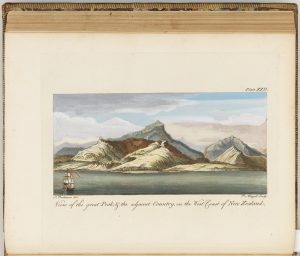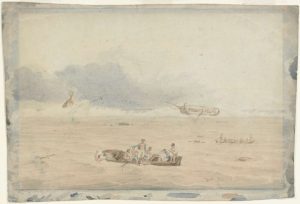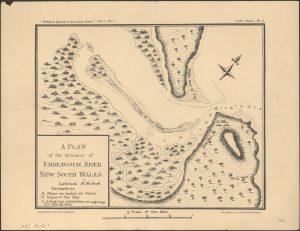14 Wooden explorers
Without the ships there would have been no European expeditions to the Pacific. The wooden vessels that carried the explorers both facilitated and limited European activities in the region. Changing technology facilitated navigation, the preservation of sailors’ health, and the increasing significance of science in European objectives, but the wooden bubbles that carried Europeans across the Pacific were fallible. Many voyages did not return, and those that did had often narrowly escaped disaster, highlighting the significance of their wooden life support systems. Ships might not qualify as explorers (they lack agency), but they were essential to the European exploration of the Pacific and mapping of the outline of the Australian continent.
Shifts in European ship building technology were essential in allowing Europeans to sail the Pacific. The European discovery of the Americas hinged on the development of ships able to cross the Atlantic and able to endure the difficult conditions of the seas around the southern tip of South America. While the Dutch presence to the west of the Australian continent did not require them to cross the Pacific, that presence also depended on ships able to brave the Atlantic and to cope with the seas around the Cape of Good Hope at the tip of the African continent.
The caravels that took to the Atlantic at the end of the medieval period were heirs to a range of European ship building traditions, and of navigational tools that had become common in Europe. They drew on sturdy engineering first developed for the ships that plied the North Sea, made use of rudders rather than steering oars, and included sails with a lateen rig that allowed them to sail at an angle to the wind. The compass and the astrolabe may have come to Europe by way of the Islamic world, but they had been widely adopted by European navigators by the time Europeans began to explore the Pacific.
As European shipbuilding and navigational technology improved, European naval interests pushed into the Pacific. James Cook’s Endeavour voyage occurred early in a new phase in European Pacific voyaging, as the relevant technologies became more reliable and voyages more frequent. But even in the late eighteenth and early nineteenth centuries voyages to the Pacific remained risky, and the technologies that supported them continued to limit what it was possible to dare and to achieve.

The Endeavour offers a compelling example of the ways in which vessels were central to European exploration. The ship was selected for its Pacific voyage because of its physical attributes: it was able to sail in comparatively shallow water and had room for stores, meaning the ship and could traverse waters of uncertain depth and could voyage independently of regular resupply. These attributes also meant the ship was comparatively slow and unwieldy, factors that limited its ability to travel where its captain wished it to go. Ultimately, the Endeavour could only sail where the wind allowed, a fact evident in the journals from the voyage, and in the tracks of its route that Cook included on his maps.

The absolute centrality of the ship to exploration is apparent in surviving (and lost) records of exploration. The Endeavour narrowly escaped shipwreck on a number of occasions, and its encounter with a coral reef came close to destroying the scientific records that the voyage is famous for. Other vessels were lost, taking their European crews and their records with them: the records of the voyage of Jean François de Galaup, comte de Lapérouse end at Sydney. He took the opportunity of his encounter with the First Fleet to send a copy of his voyage records back to France, but the details of the final leg of his voyage are lost. Captains needed to balance the purpose of their voyages (exploration) against the need to return, and after the Endeavour voyage Cook denounced the dangers of sending a single ship to sail uncharted waters. He sailed with two ships on both his subsequent Pacific expeditions.
As Pacific voyages of exploration became the preserve of governments from the late eighteenth century onwards their connections to European institutions affected their voyages. Joseph Banks and Daniel Solander could only botanise at Rio de Janeiro for one day, and only by stealth, as the Portuguese Viceroy there was suspicious of the motives of a British naval voyage. Within the Pacific, interactions with islanders were also influenced by European military considerations. European ships in the Pacific were armed, and in the period of naval exploration those arms were very effective and the damage they could inflict was considerable. In Tahiti, the observatory used to record the transit of Venus was placed where it could be secured by the Endeavour’s guns, linking a scientific mission with a military operation. In Aotearoa (New Zealand) concerns about the security of his ship meant that Cook fired guns even when not directly under attack.

And the needs and security of the ships shaped voyages. In the Endeavour’s case, records of the east coast of the Australian continent reflect the ship’s needs. At the conclusion of the Endeavour’s time in New Zealand the ship was in too poor shape to press southward and search for the Southern Continent, but in too good shape to simply head for the nearest known port and then begin the journey back to Europe. That the Endeavour pressed west across the Tasman, and that the east coast of the Australian continent was mapped by Cook, resulted from the physical condition of the ship. The length of time spent in different regions of the east coast was dictated by the ship. The need for fresh water to supply the ship’s crew forced the Endeavour’s rapid progress north. The ship’s need for repair led to the seven-week stay at the Endeavour River. Because of the Endeavour’s wooden frailty, the records of Australia made by members of the Endeavour’s company are largely records of the region that is now far north Queensland. The ship is also present in Cook’s detailed charts of sections of the east coast: its track is recorded, but more fundamentally, the information contained in those charts is the information needed for safe navigation of those regions by European ships.
While ships were not exactly explorers they were exploration’s enablers. Without their ships, Europeans could not have explored Oceania. The abilities, limitations, and needs of their ships shaped European encounters within the Pacific, and the ships advanced European scientific understanding of the region by carrying records and securing sites for observation. The ships also limited expeditions, preventing access to island groups without safe anchorage, and reducing the time that scientists could spend ashore as politics, or the needs for resupply, or the need to move with the wind forced ships to move on. At times the ships were unequal to the conditions they faced, sinking entire expeditions and destroying the records and collections they had amassed.
Links
Maps and online resources
Cook, James. Map of the Coast of New Zealand, discovered in the years 1769 and 1770. 1770.
Disposition of His Majesty’s Ship the Bedford, Lower Deck. c.1775.
Open access secondary sources
Brennan, Claire. “The Physical Endeavour: How a Wooden Ship Shaped Cook’s First Circumnavigation.” Journal of the Royal Australian Historical Society 105, no. 2 (2019): 135-158. https://researchonline.jcu.edu.au/61464/
Carter, W., & M. Carter. “The Age of Sail: A Time when the Fortunes of Nations and Lives of Seamen Literally Turned with the Winds Their Ships Encountered at Sea.” Journal of Navigation 63, no. 4 (2010): 717-731. https://apps.dtic.mil/sti/pdfs/ADA528454.pdf
Sorrenson, Richard. “The Ship as a Scientific Instrument in the Eighteenth Century.” Osiris 11 (1996): 221–36. http://www.jstor.org/stable/301933
Other secondary sources
Dening, Greg. Mr Bligh’s Bad Language: Passion, Power, and Theatre on the Bounty. Cambridge: Cambridge University Press, 1992.
Rodger, N.A.M. The Wooden World: An Anatomy of the Georgian Navy. London: Collins, 1986.
Watt, J. , E. J. Freeman and W. F. Bynum (eds). Starving Sailors: The influence of Nutrition upon Naval and Maritime History. London: National Maritime Museum, 1981.

